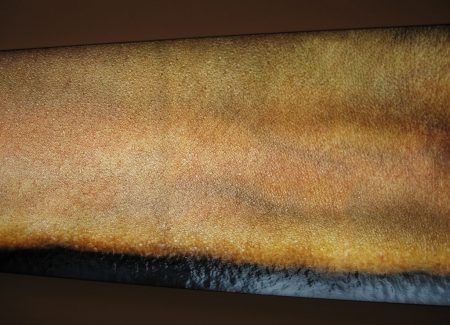JTF (just the facts): Six dye-sublimation prints on synthetic fabric stretched over light boxes. The works are dated between 2015–2017 and range in size from 146x58x4 inches to 223x58x4 inches. (Installation shots below.)
Comments/Context: Over the past two decades, New York–based artist Seth Price, now in his mid-40s, has produced, among other items, vacuum-formed relief sculptures of flowers and bomber jackets; music videos (first released on YouTube) that set found imagery—computer animation loops, and military, commercial and news footage—to soundtracks of his own music and readings from his fairy tales; a novel about an artist named Seth Price; a ready-to-wear clothing collection—in collaboration with fashion designer Tim Hamilton—featuring fabrics based on security envelope patterns; an influential critical text on the place of art in the expanded field of distributed media; and an online database containing the profiles of over four thousand art collectors.
Like many of his post–Pictures Generation peers, Price’s work continues earlier Pop, conceptual, and appropriation artists’ preoccupation with mass culture while, at the same time, reflecting on our increasingly fluid media landscape. One of his primary concerns is the interface between us and our technologies—an interest literalized in this exhibition of six tall, narrow light boxes, each covered with fabric printed with a greatly enlarged view of a section of human skin. To make the pieces, Price used a robotic camera to capture thousands of pictures of a small area of a model’s arm or leg. The pictures were then digitally stitched together and—according to the wall text—adjusted by a fashion retoucher.
The resulting images—between 12 and 18 feet high—are both recognizably human and eerily synthetic. A strip of pinkish skin, traced with pale blue veins, seems to dissolve along one edge into rippling blackness. At the bottom of a somewhat darker column of flesh, a blemish—perhaps an age spot—rises like a rocky outcrop in a desert, while digital artifacts hover, like high-level clouds in a satellite photo, over the whole. In some works, the flattening of the limb’s rounded form has resulted in jagged outlines and interior disruptions, intensifying the impression of our outermost layer as a fragile scrim. While they may be perfectly benign, a scattering of black eruptions over a field of softl wrinkles turns another light box into a contemporary memento mori.
These views of others’ bodies are intimate, but not tender. So uncanny are they that the names of the models start to sound less like the names of real people and more like the names given to the health insurance companies, glasses frames, and digital personal assistants that populate our lives. In his art, Price doesn’t moralize about or politicize the darker aspects of today’s infosphere. Rather, his eccentric, multivalent output speaks dispassionately, often brilliantly both of our time and of the human condition.
Collector’s POV: Since this is a museum show, there are of course no posted prices. Seth Price is represented by Petzel Gallery in New York (here). His photographic work has little secondary market history, so gallery retail likely remains the best option for those collectors interested in following up.



















